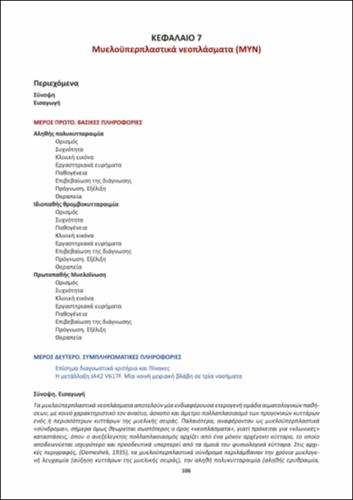| Title Details: | |
|
Myeloproliferative Neoplasms (MPN) |
|
| Other Titles: |
Polycythemia; Thrombocytosis; Myelofibrosis |
| Authors: |
Loukopoulos, Dimitris |
| Reviewer: |
Konstantopoulos, Konstantinos |
| Subject: | MEDICINE AND HEALTH SCIENCES, LIFE SCIENCES, BIOLOGICAL SCIENCES > HEALTH SCIENCES > MEDICINE > CLINICAL MEDICINE MEDICINE AND HEALTH SCIENCES, LIFE SCIENCES, BIOLOGICAL SCIENCES > HEALTH SCIENCES MEDICINE AND HEALTH SCIENCES, LIFE SCIENCES, BIOLOGICAL SCIENCES > HEALTH SCIENCES > MEDICINE > PATHOLOGY MEDICINE AND HEALTH SCIENCES, LIFE SCIENCES, BIOLOGICAL SCIENCES > HEALTH SCIENCES > MEDICINE > PUBLIC HEALTH > PREVENTIVE MEDICINE |
| Description: | |
| Abstract: |
The Myeloproliferative Neoplasms (MNP) comprise an extremely heterogeneous group of blood diseases whose common characteristic is the unjustified and uncontrolled proliferation of one or more various myeloid series. Their earlier term was myeloproliferative“syndromes” but, at this moment, the term “neoplasms” is more appropriate since they all represent clonal situations, where the uncontrolled proliferation starts form a single stem cell, which has better survival capacities than its’ peers, and gradually replaces all of them. Initially (Dameshek, 1935), the MNP included the chronic myelogenous leukemia (increase of the granular series), the polycythemia vera (increase of the erythroid elements), the thrombocythemia (increase of megaryocytes and platelets) and the idiopathic myelofibrosis (increased fibrosis of the marrow). To-day, the list has enlarged by the inclusion or a large number of less clearly defined but closely similar conditions, while CML is considered separately because it has a clear pathogenetic mechanism. An updated classification of the MNP has been compiled by the WHO in 2008. At the molecular level, the MNP have a more or less common mechanism: this comprises various chromosomal translocations or DNA mutations which super-activate an array of genes involved in the intracellular signal transduction leading to excessive cellular proliferation.
|
| Linguistic Editors: |
Klada, Nektaria |
| Graphic Editors: |
Papakosmas, Ioannis |
| Type: |
Chapter |
| Creation Date: | 2015 |
| Item Details: | |
| License: |
http://creativecommons.org/licenses/by-nc-sa/3.0/gr |
| Handle | http://hdl.handle.net/11419/3094 |
| Bibliographic Reference: | Loukopoulos, D. (2015). Myeloproliferative Neoplasms (MPN) [Chapter]. In Loukopoulos, D., & Politou, M. 2015. Hematology lessons [Undergraduate textbook]. Kallipos, Open Academic Editions. https://hdl.handle.net/11419/3094 |
| Language: |
Greek |
| Is Part of: |
Hematology lessons |
| Number of pages |
12 |
| Publication Origin: |
Kallipos, Open Academic Editions |

